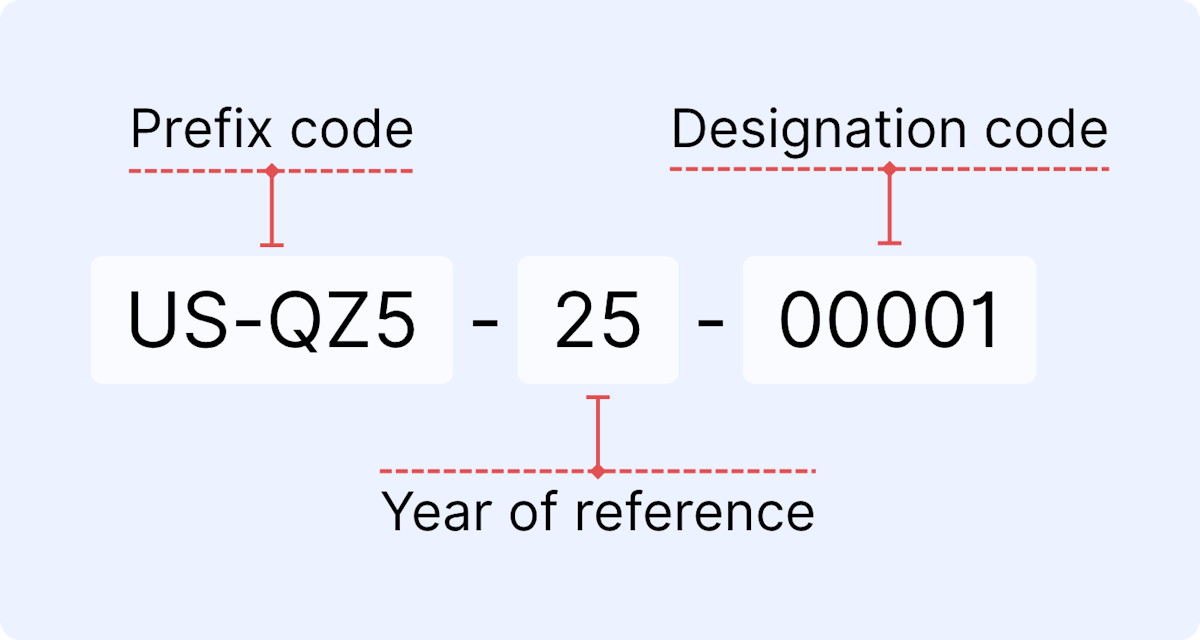An ISRC (International Standard Recording Code) is a 12-character identifier for a specific sound recording or music video. In music, the ISRC code uniquely tags each version (studio, live, remix, remaster) so plays, credits, and royalties are tracked correctly across platforms.
What is an ISRC?
Think of it as a digital fingerprint embedded in the track’s metadata—ensuring it can be tracked, credited, and monetized across platforms and territories.
Each new version of a recording—studio, live, remix, or remaster—receives its own ISRC. This ensures that royalty reporting, rights management, and metadata systems don’t confuse one version with another.
The system was introduced in 1986 under the international standard ISO 3901 and is managed globally by the IFPI (International Federation of Phonographic Industry). Since 1989, it has become the default global standard for identifying master recordings and video performances.
Why is the ISRC code important in music?
An ISRC isn’t just a technical formality—it’s what makes modern royalty collection and music tracking possible. Without it, your track could go untracked, unpaid, or even rejected by platforms.
It ensures:
- Royalties go to the right people. Every stream, download, or radio play is reported using the ISRC, making sure the rights holder is paid.
- Your recording is uniquely identified, even if the same track exists in different versions (live, remixed, remastered).
- Digital platforms can manage your music correctly. Most music distributors and DSPs require an ISRC code for uploads; it keeps music metadata consistent and royalty tracking accurate across Spotify, Apple Music, YouTube, and radio reports.
- Your data stays clean. Clear metadata avoids mix-ups between similar recordings in different territories or systems. Soundcharts can help you track your catalog and keep your metadata consistent!
Not assigning an ISRC can cost revenue and visibility — platforms may reject the track, and royalty systems won’t know who to pay. Assigning a unique ISRC ensures rights holders are correctly credited and paid worldwide.
How is an ISRC code structured?
The ISRC is composed of 12 alphanumeric characters, broken into four elements:
Example: US-QZ5-25-00001
- US-QZ5 — The prefix code, a five-character block (two letters and three alphanumerics) assigned by the national ISRC agency. Prior to 2019, the first two letters often reflected the country of assignment, but the current ISO 3901:2019 standard treats the prefix as a single unit, without fixed geographic meaning.
- 25 — The year of reference, indicating when the ISRC was assigned. This is not necessarily the same as the recording or release year.
- 00001 — The designation code, a five-digit number that uniquely identifies the recording within the registrant’s annual sequence.
Once assigned, an ISRC is permanent—it should never change, even if the track switches distributors or rights holders.

ISRC code structure
How to get an ISRC code (distributor, agency, third-party)
There are three main ways to get an ISRC:
- Through a distributor: If you use platforms like DistroKid, TuneCore, or Unchained Music, an ISRC is usually assigned automatically when you upload your track. It’s often listed in your release dashboard or metadata report.
- From a national agency: If you want to create your own ISRCs, you can apply for a registrant prefix from the agency in your country. In the U.S., this is handled by the RIAA. The one-time fee is around $95. Once approved, you can generate codes yourself, following IFPI rules.
- Via a third party: Some label services, aggregators, or mastering engineers can assign ISRCs for you—especially if they’re authorized by your local agency.
Creating your own ISRCs gives you more control, but also more responsibility. You’ll need to track your assignments, avoid duplicates, and make sure codes are valid and consistent. This is especially useful for labels managing large catalogs or artists with many versions of the same track.
Where to find the ISRC of a track
You can usually find a song’s ISRC in your distributor or label dashboard (under release or track details).
If you’re signed to a label, it’s often listed in the mastering or metadata sheet provided by the engineer.
Some public tools like ISRC Finder or IFPI databases also allow you to search ISRCs, though results can be incomplete or outdated.
For teams handling large catalogs, it’s much faster to use an ISRC API integration instead of manual lookup — it ensures accurate, cross-platform song identification and metadata linking.
ISRC vs UPC (and ISWC): what’s the difference?
Understanding how ISRC compares to other industry identifiers helps clarify its role in metadata and royalties.
People often confuse ISRCs and UPCs, but they serve different purposes:
- An ISRC identifies a specific recording—like a single song, remix, or alternate take.
- A UPC (Universal Product Code) identifies a product—like an album, EP, or a full digital release.
- ISWC (International Standard Musical Work Code) identifies the composition or songwriting work behind the recording. It’s mainly used by publishers and PROs to track publishing royalties.
If a playlist includes five versions of the same track, each version needs its own ISRC, all tied to the same ISWC. The playlist as a product might have one UPC.
ISRCs help track recordings and master royalties, ISWCs ensure songwriters get publishing royalties, and UPCs manage product sales and charting.
Common ISRC mistakes to avoid
- Reusing one ISRC for multiple versions. Each version of a recording (live, remix, radio edit) must have its own code — reusing one breaks tracking and confuses royalty systems.
- Forgetting to assign a new ISRC for remasters or alternate takes. Even small updates like remasters require a new identifier to ensure correct metadata and payments.
- Mixing up ISRC with ISWC or UPC. The ISRC identifies the recording, while ISWC refers to the composition and UPC to the overall release — each serves a different role in rights management.
- Changing distributors but replacing the ISRC. Your ISRC stays the same across all platforms and distributors; it’s permanent once assigned.
Go further:
- ISRC API for developers — access 60M+ verified ISRCs and cross-platform track IDs.
- UPC Code in Music — understand how ISRC and UPC work together in metadata.
Updated: October 2025, defined by ISO 3901 and administered globally by the IFPI through national agencies like the RIAA, SCPP, or SPPF.



